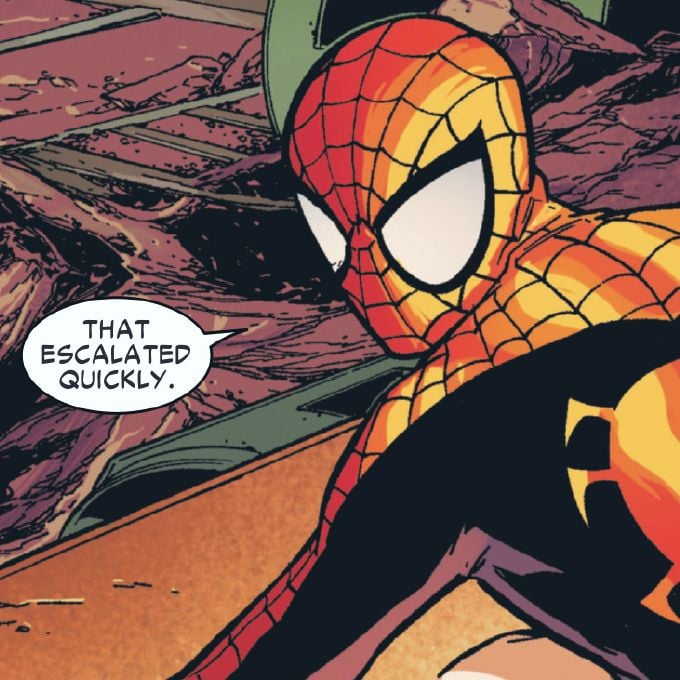The pile of gravel got me
So, is that gravel…just free? Like, can anyone just take it?
Depends on who sees you
😂
100% correct! (Not that I’ve ever taken something just laying there that wasn’t mine.)
I live in a small town next to a giant pile of gravel lol It’s probably not free. In my case, the owner of the property was planning on putting in a gravel driveway to a old house he was going to fix up but then never did. It’s been abandoned for years, no idea what’s going on now. But he owns the gravel and taking it would be theft. Although I could probably get away with it if I was in a desperate gravel situation.
Well, if it’s a desperate gravel situation that’s fair. I think we can all relate to that.
In the Great Depression, when people would leave their farms, it was common for their neighbors to strip their house to the foundations. However, if that person came back, it was also common for those neighbors to give most of what they took back, and even help rebuild. I think there’s an argument to be made that stealing something that isn’t being used isn’t stealing in a traditional sense, but more ensuring appropriate usage of resources and lessening waste.
Is this a free pennies joke from some movie? Sounds so familiar 🤔
I was heavily misquoting a scene from Ted 2 from memory 🙃
Here is an alternative Piped link(s): https://piped.video/watch?v=pnaRvqTlFgg
Piped is a privacy-respecting open-source alternative frontend to YouTube.
I’m open-source, check me out at GitHub.
Star Spangle intensifies
Your picture is actually of active, well-used railroad tracks. Old unused tracks are rusty and weed-grown. If the rails are shiny it means that trains pass regularly and knock the rust off. If there’s no weeds it’s because the railroad actively sends out crews to maintain the tracks.
the railroad actively sends out crews to maintain the tracks.
Damn, the railroad spawns its own crews for maintenance? That’s crazy
I was just in Japan and even some of their active rail lines have huge 4 ft tall weeds growing in the rail yards
Weed control is a fairly new thing but not an environmentally friendly thing. Maybe Japan doesn’t like spraying pesticide all around.
Wouldn’t surprise me. In Germany the largest customer for Roundup/Glyphosate is DB, they spray that shit over around all rails.
So THAT’S what looked off… And reminded me of where I moved out of…
Used to have a really nice commuter rail that connected to the city, now there’s a six-lane highway that clogs up twice a day.
Welcome to the American dream nightmare.
love driving thru these and seeing the old signs. hate the fuckin 25mph speed traps
One time, I was driving through one of these old towns, and I got pulled over because I didn’t make a complete stop at a stop sign. Admittedly, I was in the wrong, but the judge in town was insane, and coincidentally the father of the sheriff who pulled us over. So the judge tried to have me and the people in the car executed in some crazy deathcoaster contraption unless I agreed to marry his daughter (who bore a striking resemblance to Gus Polinski) but thankfully we managed to get out of there. Also, we got to party with Digital Underground for some reason.
Did they make you repave the street too with Bessy?
Nothing but trouble in that town it sounds like. Best stay away.
Did the judge have a dick nose? Sounds like something that happened to me once.
Tupac was involved with this, right?
Yep, his first acting credit.
I lived in one of these town for four years. Just before I moved there, they’d made national news for pulling over an ambulance. It was hauling ass taking someone to the hospital, but the local cops felt that issuing a ticket was more important.
The town is also the county seat and regional state patrol center. It’s the highest ratio of law enforcement to citizens in the entire state.
The first day we arrived my wife was pulled over for doing just over 25. Welcome to town!
What traffic laws can ambulances even violate!?
They still have to follow the rules of the road. In my state legally even running code 3 (lights and sirens) they are only legally allowed to go 5mph over the limit. And if there is an accident the ambulance driver is basically automatically assumed at fault.
Ah, I sorta just assume they had some kind of wide spread exemption in a lot of situations.
There really isn’t. Most of the laws regarding that is “driving with a due regard to safety.” You can’t just blow through intersections willy-nilly. A lot of progress has been made with driving code 3. A lot of studies have shown it honestly doesn’t improve patient outcomes based on the limited time gained. There are exceptions of course.
And these towns tend to have like 2.75 cops per person and they aren’t afraid to pull you over for going 26mph.
Got pulled in one of these driving through a small town on a US highway. 55mph road until you hit the town and it’s 35mph. I missed that sign and got pulled for a warning. -_-
My area in New York is like that. It’s like “You will enjoy our scenic views, for as long as humanly possible. I don’t know why you think this state highway that is the only route through our shitty backwater town would ever be otherwise…”
It’s the 1970s car friendly town - so car friendly noone wants to go there anymore, because there is nothing than car infrastructure and car pollution. It doesn’t have to be like this, take back your towns folks!
So once upon a time, America was a place where anyone could come to get a good job. In fact, if you were walking down the street in the middle of the day, someone would stop you and say, “Come work here, please.” Practically begging you to get benefits, a pension, and you could buy a house on your salary.
This is because manufacturing was a huge part of the post-WW2 booming American economy, they needed bodies to run the machines, and you didn’t have to know anything or be specially trained, you could just go in and start being productive on day one. Shows like Mad Men, where a bunch of men were sitting around, getting paid to think, that was far more rare than it is today. Most people did something in a factory or warehouse.
Then, international trade became increasingly cheaper. Then countries with poor human rights (ie slaves) were able to undercut companies who were using an American workforce to produce the same product. As execs cut costs to keep up, the workforce became more opinionated, some forming unions, which increased the cost of labor. So beginning in the 60’s and 70’s, they started moving all the manufacturing overseas to areas with cheaper labor. My parents were from Baltimore, they and their parents and everyone they knew had all worked at Bethlehem Steel at Sparrow’s Point (a mill producing steel) almost their entire lives. In the 70’s they started decreasing the workforce, then it got sold to a German company, who moved most of the operations overseas, and by the 90’s my grandparents were basically forced into retirement with a great pension and health insurance, as guaranteed by their union.
Oddly enough this is exactly what happened with the great recession in 2008: overseas companies started offering less-regulated investment opportunities, this put pressure on our own oversight to deregulate - which they did. Then American businesses started packaging more and more risky home loans (called sub-prime loans), and investors were buying them at prime rates because home loans were such a sure thing.
I remember from my life, in a suburb of DC, when a poor family moved into the neighborhood. They had habits that we were not familiar with, to put it politely, and they kinda stuck out like a sore thumb. They only lasted a few months, then got foreclosed on. Basically what had happened was there was pressure on banks for more home loans, so they started offering loans to people who couldn’t normally afford a house, and probably didn’t fully understand the implications of a home loan. The bank probably just told them “Free Money!” and they said ok. But then they couldn’t pay, and this happened so often everyone probably remembers something like this happening around that time.
So anyway, globalization has caused these small towns that used to house workers for a factory to become frozen. Usually around the time the mill closes or massive layoffs happen, workers will move to greener pastures, businesses that relied on them will close, leaving the town in whatever state it’s in. And that’s why you see so many towns exactly like what OP is describing.
There do be the random pile of gravel.
My brother in law’s properties and philosophy is a great example of how this often happens.
He owns a number of rentals as well as a large property adjoining his home. He is always improving amd acquiring properties. I think of him as a “slum Lord with good intentions”
Anytime, and I do mean anytime, something of value comes up for free, at a discount, or in a bartering situation, his eyes become as large as saucers.
He is a “random pile of gravel” hoarder. This behavior also applies to random piles of dirt, random piles of lumber, and other random piles of shit.
He has a very neat home with a somewhat well kept yard, but his adjoining property looks like a junkyard.
Am I missing something? Aren’t most buildings bricks? Or is that just because I live in London?
Not here in the USA!
In the US houses are held together by thoughts and prayers.
Pine with a light dusting of steel & cardboard.
Plastic on exterior walls, paper and chalk on interior walls, and tar and gravel on the roof.
Early this year forest fire fighters in Alberta were complaining that new houses have so much plastic in them that they were combusting and consumed in like 5 minutes making saving them impossible and slowing the fire’s spread harder.
I’m having a hard time finding the quote. I found this explaining houses burn faster now than before because of plastic https://www.cbc.ca/news/canada/windsor/modern-homes-burn-8-times-faster-than-50-years-ago-1.1700063
Considering the ridiculous heat of those forest fires 5 minutes is believable
I can believe it; in the UK our fire regs have become rather stringent due to the Grenfell fire, though those changes are mostly on flats/buildings more then 3(?) storeis etc.
The PVC external cladding can melt from a mid to large sized bonfire 10-15 foot away. We can’t use it to clad houses above the 2nd floor, though there are exceptions if your replacing existing cladding. So if you want to add a former to your loft you have to use tiles now.
Though there’s this interesting product called magply which is roughly as strong as ply, but is made from magnesium oxide and silicate. It’s considered incombustible so you can clad with it, then render it.
I wonder if we’ll start seeing different materials used in areas prone to forest fires
Brick isn’t as common in the US. It’s more “regional.” I’m most towns, you’ll have like one or two brick buildings and that’s it. A town hall, maybe a church.
What are they built from then?
Wood and sheetrock
https://time.com/6046368/wood-steel-houses-fires/
It’s one of the few places in the world where wood is the dominant material used in new-home construction—90% of homes built in 2019 were wood-framed, according to the National Association of Home Builders.
despite lumber shortage and wildfires, tornados and wood eating insects
Lumber is cheap, concrete is expensive. If the US were to switch to concrete, construction would become substantially more expensive everywhere in the world.
It’s not like you can’t use concrete in the US even if you want to. Commercial architecture and public infrastructure use it all the time.
Wood mostly.
Bricks aren’t uncommon for commercial buildings, though they’re often painted or otherwise different colors.
Bare brick boxes are very indicative of long-gone industry, but it’s not the bricks themselves that are truly to blame for giving that impression.
London is an extremely old city. In the US, the older areas with older buildings like New York often have brick, but almost everywhere else, where most structures are less than a century old, they use alternatives. Most commonly this is lumber framing with exterior siding (either wood or plastic), interior sheet rock (“drywall”), with fiberglass insulation in between.
I feel like living in such a town would be very depressing.
Can confirm. Most of my state is like this.
This gave me big flashbacks of where I grew up. It was great as a kid, a ton of urban exploration opportunities, but I wouldn’t want to live there now.
You don’t know any different until you move out.
Except the internet has changed that to some degree (but definitely not entirely)
you’re assuming the town has internet fast enough to load more than a few pictures of the outside world per decade
Why do you think the opioid epidemic hit small town USA so hard?
Small town USA fuckin sucks.
Depends on the specific town. Some still have some life left, others are dead.
Old unused train tracks are one of my favourite things on vacation. It really is a journey into the past. So peaceful.
Is first pic near the peak district? I may have been there, unless there’s more than one bridge like that
I occasionally take the bus from NYC to a town in the Finger Lakes, and this is so true. I have been through so many towns that check off every one of these boxes.
Fellow midwesterner can confirm
Don’t forget the Pepsi machine doesn’t actually work half the time if ever.
I grew up in small town. Very. Like, a few hundred people. One school. This meme is so accurate but railway picture is wrong! Too clean. XD
Tracks should have at least a few decent sized trees growing in the middle. Or, if you’re in the Midwest US, they should dead end at a random field where a manufacturing plant once stood.
Oh, I don’t know. There’s lots of towns across the US that only came to be because it was a water stop. And in those towns the tracks still exist and the people living there commute to work.
The little town I grew up in had a trainyard and that’s why it existed. The yard is gone but there’s still active train lines going through town.
Did you just shit on pretty much the whole UK?
Would you classify your castles as “every building is bricks” or “random pile of gravel”?
I’m not British, but the vast majority of their buildings indeed seem to fall into either the “bricks” or the “gravel” category - not just castles.
All our houses are brick based. Source: own house in UK, made of bricks.
But don’t understand why it’s portrayed as bad here?
I think they might mean bricked up, as in the windows have been bricked over?
Or maybe they’re associated with buildings built during a certain period that are now mostly empty due to a boom and bust cycle?
Its not, its just a common thing.
Nope, the American midwest. Most of my state is like this.
Yea imagine buildings being made of bricks and not match sticks
I genuinely am interested. I assume this is for the US. Did houses get bulit with bricks in older days and why did they move away from it?
I live in europe an have only seen brick and cement Houses here
Cheddar actually made a good video on this topic. The US switched to wood during the postwar boom because it was faster and cheaper to build houses and buildings out of wood, because wood is abundant here.
Here is an alternative Piped link(s): https://piped.video/wpxLLCdW_Gc
Piped is a privacy-respecting open-source alternative frontend to YouTube.
I’m open-source, check me out at GitHub.





















